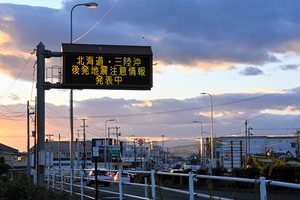By KAYOKO SEKIGUCHI/ Staff Writer
July 8, 2022 at 15:09 JST
 An electron microscope image of the Omicron variant of the novel coronavirus (Provided by the National Institute of Infectious Diseases)
An electron microscope image of the Omicron variant of the novel coronavirus (Provided by the National Institute of Infectious Diseases)
Tokyo has likely entered the seventh wave of novel coronavirus infections, fueled by the highly contagious BA.5 Omicron subvariant, health experts said.
Mitsuo Kaku, head of the Tokyo Center for Infectious Disease Control and Prevention, issued the warning at a July 7 meeting of the metropolitan government’s COVID-19 monitoring panel.
That day, the capital reported 8,529 new COVID-19 cases, 2.4 times the figure for the previous Thursday. It was the second straight day for the Tokyo count to top 8,000.
Norio Omagari of the National Center for Global Health and Medicine said at the panel meeting that Tokyo’s seven-day average of new infections could reach 16,000 in two weeks and 55,000 in four weeks if cases continue to increase at the current pace.
The panel pointed out that new cases began trending upward in the capital around the end of June partly because the BA.5 subvariant is becoming the dominant strain.
Testing conducted by the Tokyo Metropolitan Institute of Public Health between June 21 and 27 showed that 33.4 percent of suspected Omicron cases were likely caused by the BA.5 subvariant.
The figure jumped from the 25.1 percent recorded a week earlier.
The occupancy rate of hospital beds for COVID-19 patients was 28.7 percent in Tokyo on July 7. The Tokyo government has said it would consider requesting a COVID-19 state of emergency if the occupancy rate for beds set aside for those in serious condition tops 30 percent.
Data presented to the meeting showed the capital will run out of beds to treat COVID-19 patients requiring hospitalization if new cases rise to twice the figure reported at the height of the sixth wave.
But even under such a scenario, the metropolitan government has secured more than enough beds for seriously ill patients, according to the data.




















A peek through the music industry’s curtain at the producers who harnessed social media to help their idols go global.
A series based on diplomatic documents declassified by Japan’s Foreign Ministry
Here is a collection of first-hand accounts by “hibakusha” atomic bomb survivors.
Cooking experts, chefs and others involved in the field of food introduce their special recipes intertwined with their paths in life.
A series about Japanese-Americans and their memories of World War II